
Background: Despite improvements in child survival in the past four decades, an estimated 6.3 million children under the age of five die each year, and more than 40% of these deaths occur in the neonatal period. Interventions to reduce neonatal mortality are needed. Kangaroo mother care (KMC) is one such life-saving intervention; however it has not yet been fully integrated into health systems around the world. Utilizing a conceptual framework for integration of targeted health interventions into health systems, we hypothesize that caregivers play a critical role in the adoption, diffusion, and assimilation of KMC. The objective of this research was to identify barriers and enablers of implementation and scale up of KMC from caregivers’ perspective.
Methods: We searched Pubmed, Embase, Web of Science, Scopus, and WHO regional databases using search terms ‘kangaroo mother care’ or ‘kangaroo care’ or ‘skin to skin care’. Studies published between January 1, 1960 and August 19, 2015 were included. To be eligible, published work had to be based on primary data collection regarding barriers or enablers of KMC implementation from the family perspective. Abstracted data were linked to the conceptual framework using a deductive approach, and themes were identified within each of the five framework areas using Nvivo software.
Results: We identified a total of 2875 abstracts. After removing duplicates and ineligible studies, 98 were included in the analysis. The majority of publications were published within the past 5 years, had a sample size less than 50, and recruited participants from health facilities. Approximately one-third of the studies were conducted in the Americas, and 26.5% were conducted in Africa. We identified four themes surrounding the interaction between families and the KMC intervention: buy in and bonding (i.e. benefits of KMC to mothers and infants and perceptions of bonding between mother and infant), social support (i.e. assistance from other people to perform KMC), sufficient time to perform KMC, and medical concerns about mother or newborn health. Furthermore, we identified barriers and enablers of KMC adoption by caregivers within the context of the health system regarding financing and service delivery. Embedded within the broad social context, barriers to KMC adoption by caregivers included adherence to traditional newborn practices, stigma surrounding having a preterm infant, and gender roles regarding childcare.
Conclusion: Efforts to scale up and integrate KMC into health systems must reduce barriers in order to promote the uptake of the intervention by caregivers.